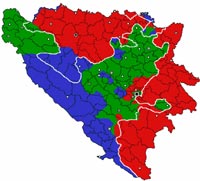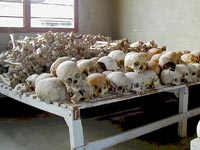This article is reposted from the old Wordpress incarnation of Not Exactly Rocket Science.
Everybody, apparently, needs good neighbours, but in many parts of the world, your neighbours can be your worst enemy. In the past century, more than 100 million people have lost their lives to violent conflicts. Most of these were fought between groups of people living physically side by side, but separated by culture or ethnicity.
 Now, May Lim and colleagues from the New England Complex Systems Institute have developed a mathematical model that can predict where such conflicts by looking at how different groups are spread out in a given area.
Now, May Lim and colleagues from the New England Complex Systems Institute have developed a mathematical model that can predict where such conflicts by looking at how different groups are spread out in a given area.
According to their research, violence is most likely to erupt in areas with poorly-defined boundaries between large and culturally different groups. Their model predicted areas of ethnic violence in both India and Yugoslavia with uncanny accuracy, and Lim hopes that it will help policymakers to look at the problem of violent conflicts with a scientific eye.
Many studies on the triggers of violence have focused on familiar issues such as historical grudges, competition over resources or religious differences. But Lim approached the problem from a new and different angle.
She tested the idea that the issues that different cultural and ethnic groups fight over are secondary to the way those groups are spread out geographically. In her vision, violence is most likely to erupt when the boundaries between these groups is poorly defined. These hazy boundaries create local hotspots of tension, which can be easily pushed into violent conflict because of other social and economic factors.
In highly-mixed areas where different communities are thoroughly integrated, no single group is large enough to dominate a particular public space or to impose their values on another. At the other end of the spectrum, large segregated groups with clear boundaries between them can exist harmoniously and independently. Simply put, people can argue fiercely over heartfelt issues, but they are more likely to remain good neighbours if they have a good fence between them.
 But trouble brews when different groups are "partially separated with poor boundaries". In these situations, certain groups become large enough to impose their own values and cultural norms in public areas, but aren't large enough to stop smaller groups to flaunt these values.
But trouble brews when different groups are "partially separated with poor boundaries". In these situations, certain groups become large enough to impose their own values and cultural norms in public areas, but aren't large enough to stop smaller groups to flaunt these values.
Lim's model was based on the same scientific principles that are used to describe how different chemicals mix and react together. To her, the collective behaviour of people, like that of molecules, can often be governed and predicted by very simple things, even though individuals can behave very differently. In this case, population structure - a simple thing to measure - can underlie a complex collective behaviour - ethnic violence.
Lim deliberately based her model on population structure alone, ignoring migration and other forces that shaped those structures in the first place. The idea was to create a tool that could predict likely trouble spots using simple census data. The model doesn't say why violence is likely to erupt, just where.
And it does that well. Lim fed her model with census data from India in 2001, and Yugoslavia in the 1990s before the terrible ethnic violence there truly began. The data included information on the relative proportions of different ethnic and religious groups across the two countries.
The model dutifully predicted conflict-prone areas, which Lim checked against reports from different media channels. The results were extremely encouraging, with the model's predictions agreeing very closely with what actually happened in both countries.
 Lim is very clear that her model isn't intended to recommend specific policy options. If either clear segregation or integration is championed in a ham-handed way, it could actually promote violence rather than prevent it.
Lim is very clear that her model isn't intended to recommend specific policy options. If either clear segregation or integration is championed in a ham-handed way, it could actually promote violence rather than prevent it.
Singapore, for example, is a model of integration and supports Lim's theory. Despite a diverse mix of religions, ethnicities and languages, group conflicts are very rare. But that's because integration has been strictly enforced - the housing blocks where most people live are only allowed to hold fixed percentages of different ethnic groups. Such authoritarian measures are unlikely to be welcomed elsewhere.
Indeed, Lim notes that her model shows that integration isn't necessary and that segregation is a worthy tactic. To her, the key is to promote policies that will create appropriate boundaries suited to the current geographical distributions of different groups, rather than historical boundaries. These boundaries do not have to block trade or create individual states, but they should allow each group to foster their own values and cultures independently.
Her overarching message is that the problem of violent conflict isn't going to be solved by being wantonly assaulted with policies and media-friendly solutions. To understand how to prevent violence, we need to understand the factors that trigger it. In an ideal situation, the policies of peace, just as those of health or crime, would be based on sound scientific evidence.
Reference: Lim, Metzler & Bar-Yam. 2007. Global pattern formation and ethnic/cultural violence. Science 317: 1540-1544.
- Log in to post comments





It seems safe to guess that the population distributions at those spots in India and Yugoslavia were not much changed from, say, ten years earlier. Why did the violence break out there and then? Does the model predict violence (and fail) year after year, and then succeed? Or does it say that if widespread violence breaks out, here are the places to expect it?
I love your blog and follow it faithfully, but I've noted a small grammatical peccadillo:
In paragraph 7, the phrase "...aren't large enough to stop smaller groups to flaunt these values," would be better stated: "...aren't large enough to keep smaller groups from flouting these values."
You missed the second part of their proposition: "poorly defined boundaries".
Communism in Yougoslavia enforced very strict boundaries on behaviour - once those boundaries were removed with the fall of communism, the ethnic powderkeg exploded.
Would love to see what this model predicts for Birmingham and other european cities which now host a very large and non-integrating semi-segregated ethnic minority.
Hm. Modern technology might allow for an interesting mix of approaches for (say) education: segregation in meatspace, integration on-line. (Preferably with video, so as to increase chance of cognitive recognition of a real person on the other end.) Of course, this presupposes the local infrastructure supports the requisite tech level....
I think that Vince has a point. You use the example of Singapore being a racially mixed society. After having lived here for 2 years I can confirm that it is an illusion, despite government efforts. Singapore is a tightly controlled society where plainclothed policemen out number the uniformed ones and I cannot say much more in an open forum.
Sectarian violence in Iraq exploded after the fall of Saddam - people of different faiths and sects seemed to live quite well together while he was around. The same for Bonsia from what I've heard.
Vince - hasn't Birmingham already had race riots a couple of years back? or was it another English city?